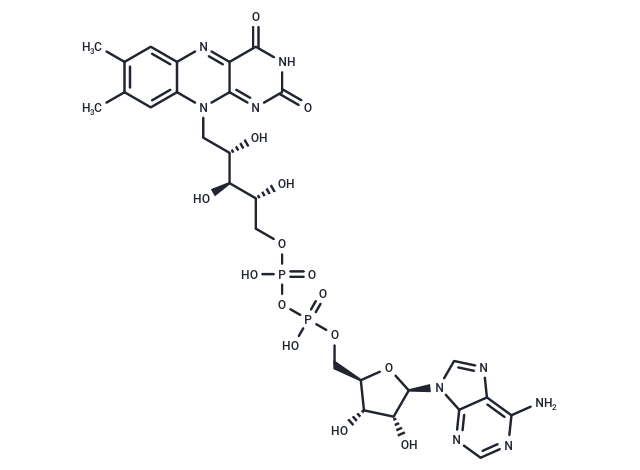Shopping Cart
Remove All Your shopping cart is currently empty
Your shopping cart is currently empty
Flavin adenine dinucleotide (FAD) is a REDOX cofactor and protein cogroup involved in various metabolic reactions.

| Pack Size | Price | USA Warehouse | Global Warehouse | Quantity |
|---|---|---|---|---|
| 5 mg | $37 | In Stock | In Stock | |
| 10 mg | $53 | In Stock | In Stock | |
| 25 mg | $88 | In Stock | In Stock | |
| 50 mg | $129 | In Stock | In Stock | |
| 100 mg | $192 | - | In Stock |
| Description | Flavin adenine dinucleotide (FAD) is a REDOX cofactor and protein cogroup involved in various metabolic reactions. |
| In vitro | Characterized by an additional polymer-type redox reaction, Poly(Flavin adenine dinucleotide, FAD) is a highly effective electrocatalyst for NADH oxidation. Operating at the lowest potentials reported for NADH transducers (0.00 V, pH 7.4), poly(FAD) exhibits an electrochemical rate constant of 1.8 ± 0.6×10-3 cm/s, which is at the level of the NADH mass-transfer constant. Poly(FAD)-modified electrodes demonstrate dramatically improved stability and are the most advantageous NADH transducers for analytical chemistry[2]. |
| In vivo | Administered intravenously at a dose of 2 mg/kg, Flavin adenine dinucleotide significantly cancels the chlorpromazine (CPZ)-induced decrease in ventricular fibrillation threshold (VFT). The effect of CPZ on canine heart mitochondria is nullified by Flavin adenine dinucleotide. Following the injection of Flavin adenine dinucleotide, the dogs experience a transient hypotension within 10 minutes, after which their blood pressures recover to the initial level. Additionally, Flavin adenine dinucleotide prevents mitochondrial dysfunction induced by chlorpromazine[1]. |
| Synonyms | FAD |
| Molecular Weight | 785.55 |
| Formula | C27H33N9O15P2 |
| Cas No. | 146-14-5 |
| Smiles | C([C@@H]([C@@H]([C@@H](COP(OP(OC[C@H]1O[C@H]([C@H](O)[C@@H]1O)N2C=3C(N=C2)=C(N)N=CN3)(=O)O)(=O)O)O)O)O)N4C=5C(=NC=6C4=CC(C)=C(C)C6)C(=O)NC(=O)N5 |
| Color | Orange |
| Appearance | Solid |
| Storage | keep away from direct sunlight,store at low temperature | store at 4°C | Shipping with blue ice/Shipping at ambient temperature. | |||||||||||||||||||||||||||||||||||
| Solubility Information | H2O: 125 mg/mL (159.12 mM), Sonication is recommended. | |||||||||||||||||||||||||||||||||||
Solution Preparation Table | ||||||||||||||||||||||||||||||||||||
H2O
| ||||||||||||||||||||||||||||||||||||
| Size | Quantity | Unit Price | Amount | Operation |
|---|

Copyright © 2015-2026 TargetMol Chemicals Inc. All Rights Reserved.